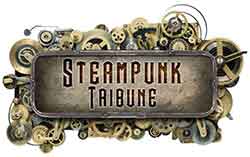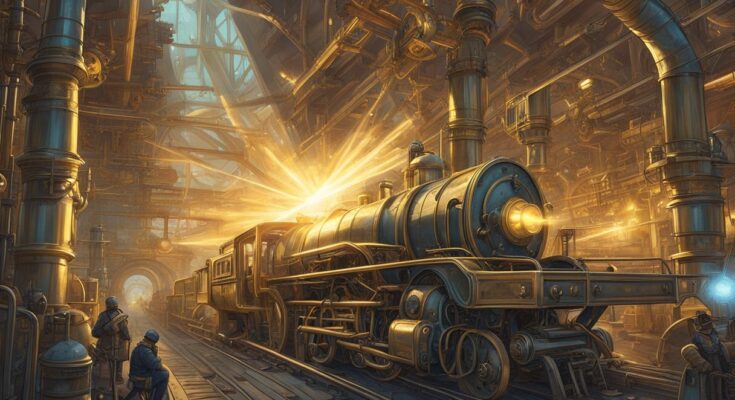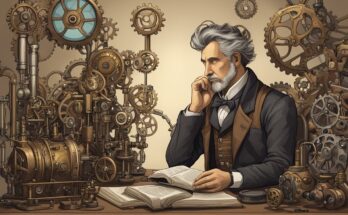Raypunk is a subgenre of science fiction that has been gaining popularity in recent years. It is a fusion of two distinct styles: steampunk and raygun gothic. Steampunk is characterized by its Victorian-era aesthetic, while raygun gothic is known for its futuristic, space-age look. Raypunk blends these two styles together to create a unique and visually stunning world.

The term “raypunk” was first coined by author and illustrator Dave Stevens in the 1980s. It was used to describe his own work, which combined elements of classic pulp fiction with a retro-futuristic aesthetic. Since then, the term has been adopted by other artists and writers to describe a broader range of works that share similar themes and styles.
Raypunk is often associated with a sense of adventure and exploration. It imagines a world where technology has advanced far beyond our own, but where humanity still faces many of the same challenges and struggles. It is a world of airships, robots, and rayguns, where heroes and villains battle for control of the future.
What is Raypunk
Raypunk is a subgenre of science fiction that combines elements of punk and futuristic art. The term “ray” refers to the use of ray guns and other advanced technology, while “punk” refers to the rebellious and anti-authoritarian attitude of the punk movement. Raypunk is characterized by its emphasis on technology, often featuring advanced gadgets and machinery, and its focus on the individual’s relationship with technology.
In Raypunk, technology is often portrayed as both a tool and a threat. While it can provide humans with incredible power and freedom, it can also be used to control and manipulate them. This tension between technology and individual freedom is a central theme in Raypunk.
Raypunk is also known for its unique visual style. It often features retro-futuristic designs with a sleek and shiny aesthetic. The use of neon colors, metallic surfaces, and geometric shapes are common in Raypunk art.
Overall, Raypunk is a subgenre of science fiction that explores the relationship between humans and technology. It combines elements of punk and futuristic art to create a unique and visually striking world.
Historical Context and Origins

Raypunk is a subgenre of science fiction that combines the aesthetics and themes of the Golden Age of Science Fiction with the technology and culture of the Atomic Age. It is characterized by its retro-futuristic style, which often features ray guns, rocket ships, and other futuristic technologies from the 1930s and 1960s.
The origins of Raypunk can be traced back to the science fiction of the 1930s, which was heavily influenced by the technological advancements of the time. This period, known as the Golden Age of Science Fiction, saw the rise of writers such as Isaac Asimov, Arthur C. Clarke, and Robert A. Heinlein, who explored the possibilities of space travel and other advanced technologies.
In the 1960s, science fiction underwent a transformation as writers began to explore the social and cultural implications of technology. This period, known as the New Wave, saw the rise of writers such as William Gibson, who explored the impact of technology on society and culture.
Raypunk draws on both of these periods, combining the retro-futuristic style of the Golden Age with the social and cultural commentary of the New Wave. It is a genre that celebrates the optimism and sense of wonder of early science fiction while also exploring the darker side of technology and its impact on society.
Overall, Raypunk is a genre that is deeply rooted in the history of science fiction, drawing on the themes and aesthetics of the past to create a unique and compelling vision of the future.
Raypunk Aesthetics and Design
Raypunk is a subgenre of science fiction that features a distinct aesthetic and design style. This style is characterized by a blend of retro and futuristic elements, with a focus on sleek lines, geometric shapes, and architectural design.
One of the key influences on Raypunk design is the Art Deco movement of the 1920s and 1930s. This style is characterized by its use of bold geometric shapes, sleek lines, and a focus on modernity and industrialization. Raypunk design takes these elements and combines them with futuristic elements, creating a unique and distinct aesthetic.
In terms of architecture, Raypunk design often features towering skyscrapers, futuristic transportation systems, and other elements that emphasize the grandeur and scale of the future. The use of sleek lines and geometric shapes helps to create a sense of order and harmony in these futuristic landscapes.
Another key element of Raypunk design is the use of technology. Futuristic gadgets, robots, and other advanced technologies are often featured prominently in Raypunk stories and designs. These elements are often designed with a focus on functionality and efficiency, as well as aesthetic appeal.
Overall, Raypunk design is a unique and distinctive style that blends retro and futuristic elements to create a bold and exciting visual aesthetic. With its focus on sleek lines, geometric shapes, and architectural design, Raypunk design is sure to continue to inspire and captivate audiences for years to come.
Raypunk in Literature
Raypunk is a subgenre of science fiction that is characterized by a retro-futuristic aesthetic influenced by the style of the 1920s and 1930s. In literature, Raypunk often features advanced technology and futuristic concepts set in an alternate history or a parallel universe.
The term “Raypunk” was coined by author and editor Paul Di Filippo in 1999, and it has since become a popular subgenre among science fiction fans. Raypunk draws inspiration from the pulp magazines of the early 20th century, particularly Amazing Stories and Astounding Science Fiction, which were edited by John W. Campbell.
One of the earliest examples of Raypunk literature is H.G. Wells’ The Time Machine, which was published in 1895. The novel features a time traveler who journeys to the distant future and encounters a society that has devolved into two distinct species, the Eloi and the Morlocks. The Time Machine is notable for its blend of science fiction and social commentary, and it has been adapted into numerous films and television shows.
Another influential Raypunk work is William Gibson’s Neuromancer, which was published in 1984. The novel is set in a dystopian future where artificial intelligence has become a reality, and it features a hacker named Case who is hired to pull off a seemingly impossible hack. Neuromancer won the Nebula Award, the Hugo Award, and the Philip K. Dick Award, and it is widely regarded as a classic of the cyberpunk genre.
Raypunk literature often explores themes of technology, society, and the human condition, and it has inspired numerous authors and filmmakers to create their own works in the genre. The pulp magazines of the early 20th century, particularly Amazing Stories and Astounding Science Fiction, were instrumental in shaping the Raypunk aesthetic, and the legacy of editor John W. Campbell continues to influence science fiction to this day.
In the 1940s, Campbell launched a series of articles called “Operation Future,” which encouraged readers to submit ideas for new technologies and inventions. This concept of “futurism” has become a hallmark of Raypunk literature, which often features advanced technology and futuristic concepts. Overall, Raypunk is a vibrant and exciting subgenre of science fiction that continues to evolve and inspire new works of literature and storytelling.
Raypunk in Film and Television
Raypunk has had a significant impact on the world of film and television. From classic science fiction films like “Forbidden Planet” to modern animated series like “Futurama,” the genre has influenced a wide range of productions.
One of the earliest examples of Raypunk in film was the 1936 classic “Flash Gordon.” The film featured a futuristic world filled with advanced technology, space travel, and evil villains. Similarly, the 1950s television series “Buck Rogers” featured a world of advanced technology and space travel.
In the 1960s, “Star Trek” took Raypunk to new heights, with its depiction of a utopian future society filled with advanced technology and interstellar travel. The show’s influence can still be felt in modern science fiction productions.
The 1960s also saw the release of “The Jetsons,” an animated series that featured a futuristic world filled with flying cars and advanced technology. The show’s influence can be seen in modern animated productions like “The Incredibles” and “Meet the Robinsons.”
In the 1990s, “The Iron Giant” showcased a world of advanced technology and a robot with a heart. The film’s themes of humanity and technology continue to resonate with audiences today.
More recently, “Futurama” has become a beloved animated series that features a world of advanced technology and space travel. The show’s humor and clever writing have made it a favorite among science fiction fans.
Other examples of Raypunk in film and television include “Destroy All Humans,” “Duck Dodgers,” “Johnny Quest,” and “Foundation.” All of these productions have been influenced by the Raypunk genre in various ways, and continue to inspire new generations of science fiction fans.
Raypunk’s Relation to Other Subgenres

Raypunk is a subgenre of science fiction that is often compared to other subgenres such as cyberpunk, steampunk, and dieselpunk. While there are similarities between these subgenres, they each have their own unique characteristics and themes.
One of the most significant differences between raypunk and other subgenres is its focus on rayguns and other futuristic weaponry. This sets it apart from steampunk, which is more focused on steam-powered technology, and dieselpunk, which is centered around diesel-powered machinery.
Raypunk also has strong ties to cyberpunk, as both subgenres explore the relationship between humans and technology. However, while cyberpunk often portrays a dystopian future where technology has taken over, raypunk tends to have a more optimistic view of the future.
Another subgenre that raypunk is often compared to is atompunk, which is set in a world where nuclear power is the dominant energy source. While atompunk and raypunk share some similarities, such as their focus on futuristic technology, atompunk tends to have a more retro-futuristic aesthetic.
In terms of dystopian themes, raypunk shares similarities with other subgenres such as cyberpunk and biopunk, which explore the negative consequences of technology on society. However, raypunk tends to focus more on the positive aspects of technology and its potential to improve society.
Overall, while raypunk shares similarities with other science fiction subgenres, it has its own unique themes and characteristics that set it apart.
The Impact of Raypunk on Society and Culture

Raypunk has had a significant impact on society and culture since its emergence. It has influenced various aspects of society, including fashion, art, literature, and music. The movement has also inspired many individuals to create their own works of art, literature, and music, which has contributed to the growth of the movement.
One of the most significant impacts of Raypunk on society is its nostalgic appeal. The movement has revived the nostalgia for the 50s and 60s, which has become a significant part of popular culture. Raypunk has also provided an optimistic view of the future, which has been a refreshing change from the dark and dystopian visions of the future that were popular in the past.
Raypunk has also had a significant impact on the world of technology. The movement has inspired many technological advancements, particularly in the field of nuclear power. The movement’s vision of the future has also influenced the development of futuristic technology, such as flying cars, robotic assistants, and space travel.
Overall, Raypunk has had a profound impact on society and culture. Its optimistic vision of the future, combined with its nostalgic appeal, has inspired many individuals to create their own works of art, literature, and music. The movement has also influenced the development of futuristic technology, particularly in the field of nuclear power.
Raypunk in Music and Other Forms of Entertainment
Raypunk has not only influenced literature and visual arts but also music and other forms of entertainment. In music, Raypunk is characterized by the use of retro-futuristic sounds and themes, often incorporating elements of jazz, swing, and big band music.
One of the most notable Raypunk musicians is Doctor Steel, who combines elements of rock, pop, and electronic music with a science fiction and fantasy aesthetic. Another example is Stereolab, a British band that incorporates vintage electronic instruments and a retro-futuristic sound into their music.
In addition to music, Raypunk has also influenced other forms of entertainment, such as adventure and fantastical storytelling. The New Albion Guide to Analog Consciousness, a musical theater production by Paul Shapera, tells the story of a city in a dystopian future where people are implanted with devices that control their emotions and behavior. The story features elements of steampunk, cyberpunk, and Raypunk.
Raypunk has also found a home in the world of filk, a genre of music that involves creating parodies and original songs based on science fiction and fantasy themes. Tom Smith, a prominent filk musician, has written several Raypunk-inspired songs, including “Zombie Pirates in Love” and “The Illuminati Polka.”
In comics and graphic novels, Raypunk has been used to create visually stunning worlds and characters. Warren Ellis’s “The Gernsback Continuum” and Gianluca Pagliarani’s “Magnus Robot Fighter” are both examples of Raypunk-inspired comics. Scott McCloud’s “Zot!” is another example of a comic that incorporates Raypunk elements into its storytelling.
Overall, Raypunk has had a significant impact on various forms of entertainment, creating unique and imaginative worlds that capture the imagination of audiences.
Raypunk’s Influence on Architecture and Machinery
Raypunk has had a significant impact on the design of architecture and machinery. The movement’s focus on blending futuristic and antique elements has led to the creation of unique and visually striking designs that have been applied to various fields.
In architecture, Raypunk has influenced the design of buildings and structures, with its signature blend of Victorian and futuristic elements. The movement’s influence can be seen in the design of buildings like the Steampunk Tower in Belgrade, Serbia, which features a clock tower with gears and cogs, and the Raypunk-inspired Biosphere in Montreal, Canada, which features a geodesic dome with a futuristic design.
In machinery, Raypunk has influenced the design of vehicles, gadgets, and other mechanical devices. The movement’s focus on combining antique and futuristic elements has led to the creation of unique and visually stunning designs that have been applied to various fields. For example, the Crysis video game series features Raypunk-inspired nanosuits that combine futuristic technology with a worn and weathered appearance.
Overall, Raypunk’s influence on architecture and machinery has been significant, with its unique blend of antique and futuristic elements creating visually striking designs that have been applied to various fields.
Conclusion

In conclusion, Raypunk is a subgenre of science fiction that combines elements of both Raygun Gothic and Steampunk. It is characterized by its retro-futuristic aesthetic and its focus on technology that is powered by steam or other alternative energy sources. Raypunk often features advanced technology that is designed to look like it was created during the early 20th century, and it often incorporates elements of adventure and exploration.
While Raypunk is a relatively new subgenre, it has already gained a significant following among science fiction fans. Its unique blend of retro and futuristic elements offers a fresh take on traditional science fiction themes, and its focus on alternative energy sources and sustainability makes it a timely and relevant genre in today’s world.
Overall, Raypunk is an exciting and innovative subgenre of science fiction that is sure to continue to grow in popularity in the years to come. Whether you are a fan of science fiction or simply enjoy exploring new and unique genres, Raypunk is definitely worth checking out.




